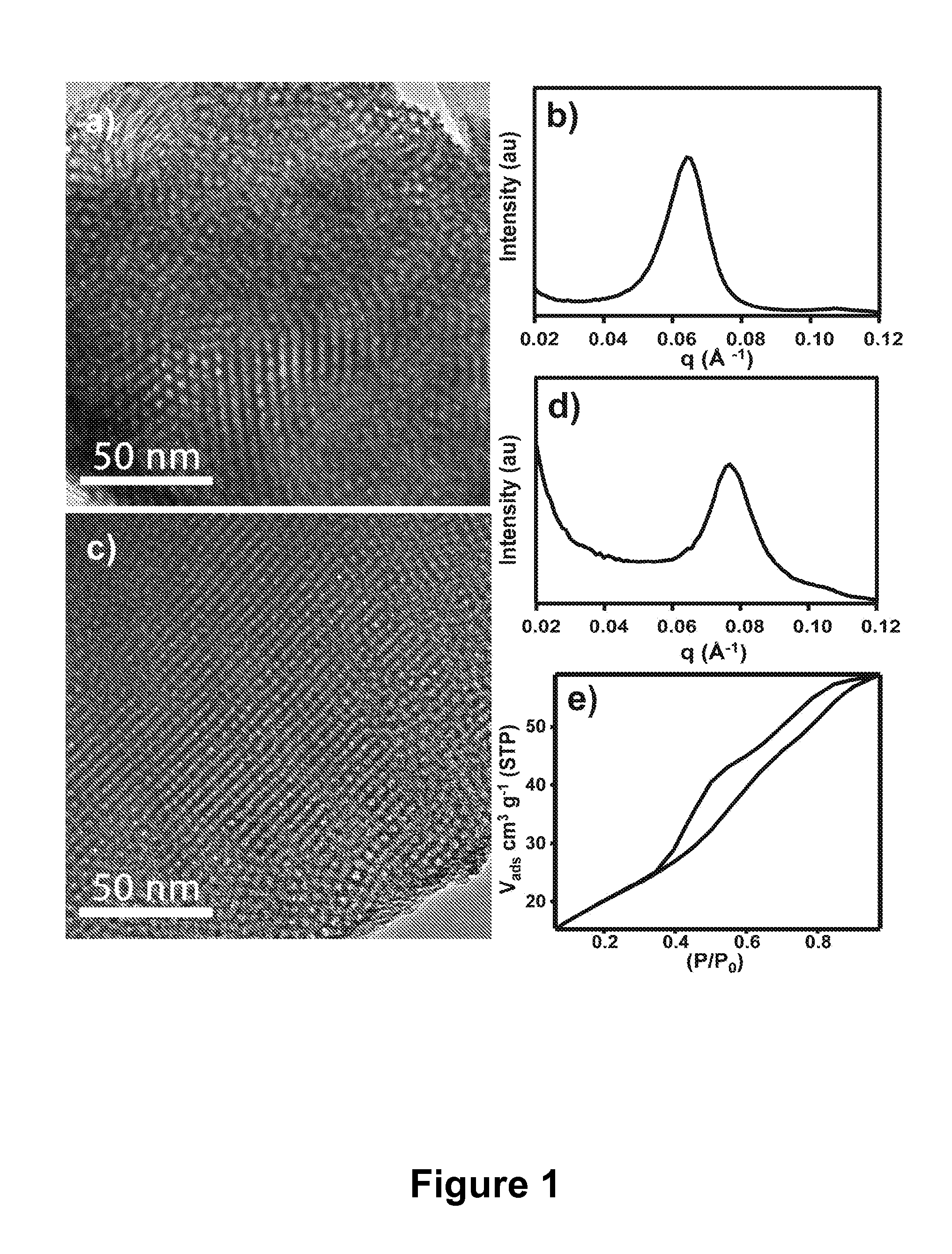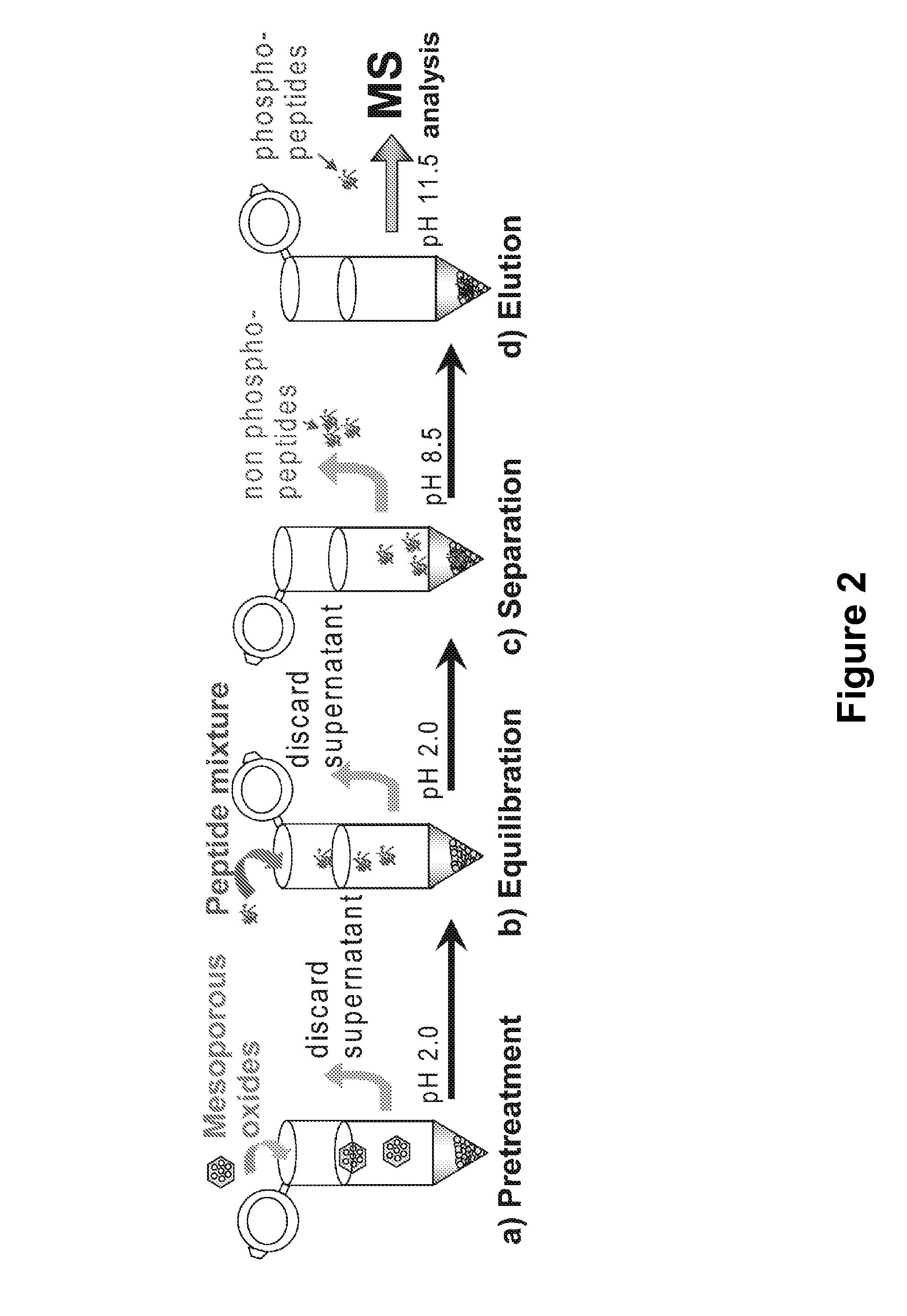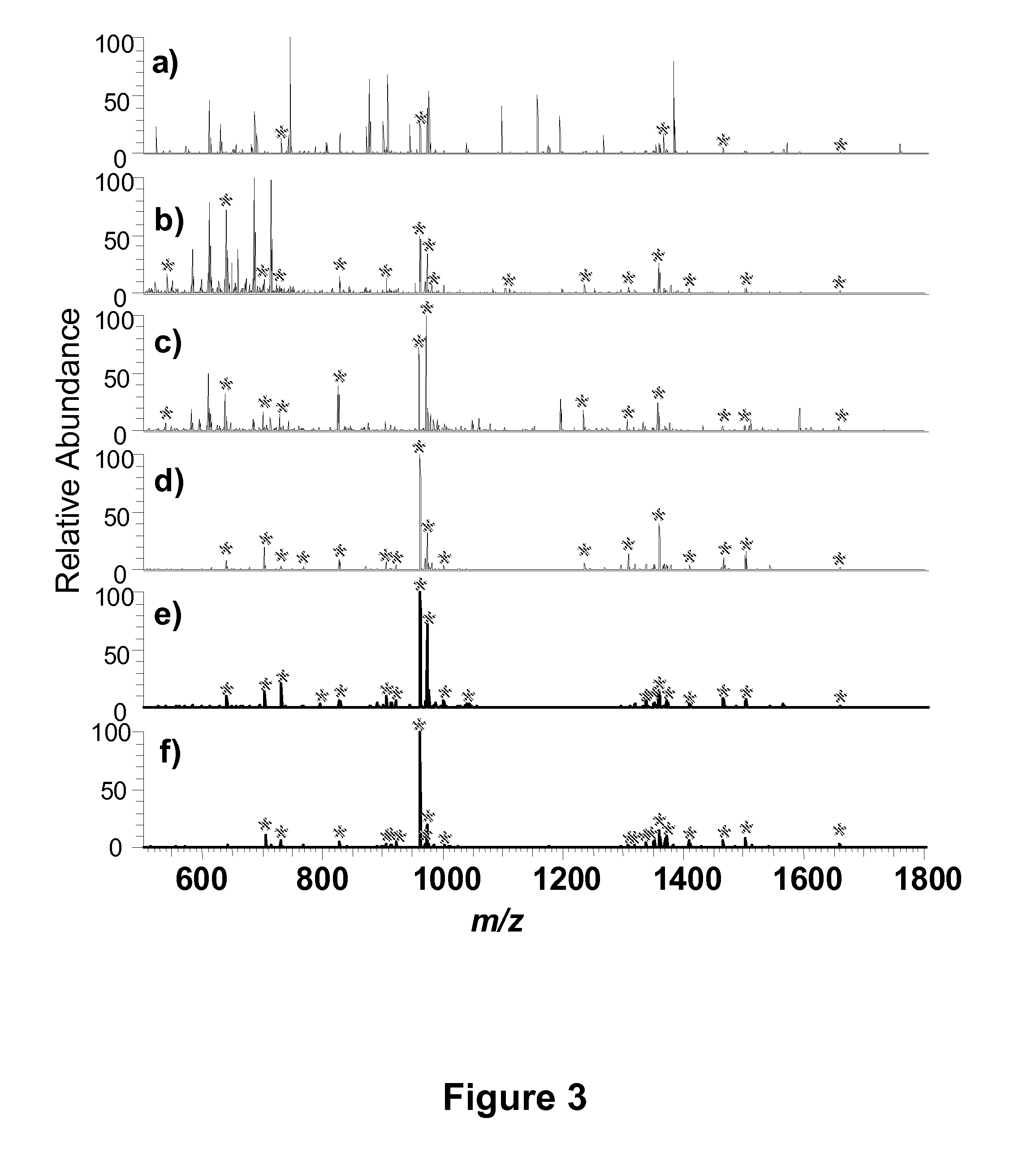[0012]The present invention provides methods and materials for isolating, purifying, and / or enriching the concentration of compounds having one or more
phosphate groups and / or derivatives thereof, including but not limited to phosphorylated peptides and / or
phosphorylated proteins. In some aspects, the present invention provides nanostructured enrichment materials, such as
metal oxide mesoporous materials including
transition metal oxide and / or Group IIIA
metal oxide mesoporous materials that selectively and reversibly bind with phosphorylated compounds with high specificity and are capable of
controlled release of phosphorylated compounds bound to their active surfaces. Mesoporous materials of some aspects have a well-ordered nano-pore structure providing enrichment materials exhibiting large active areas of exposed surfaces (e.g., greater than or equal to 50 m2 g−1) resulting in higher loading capacities for phosphorylated peptides and proteins relative to conventional affinity based methods.
Nanostructured metal oxide mesoporous enrichment materials of some of the present methods are also compatible with implementation via a variety of separation platforms including flow through separation systems,
elution based separation systems,
column chromatography and
affinity chromatography.
[0013]The methods and nanostructured enrichment materials of the present invention are highly versatile and, thus applicable for enrichment, purification and analysis of phosphorylated compounds in a range of samples, including biological samples derived from living cells and tissue. The large
active surface areas of mesoporous materials of the present invention make these methods particularly attractive for enrichment of phosphorylated
protein and / or
peptide component(s) present over a wide range of concentrations including very low concentrations. In addition, the high degree of selectivity of metal oxide mesoporous materials for phosphorylated compounds, particularly phosphopeptides and phosphoproteins, provides separation media useful for purifying, enriching and analyzing the components of complex mixtures. Methods and
nanostructured materials of the present invention are highly complementary to
mass spectrometric-based methods for the identification, analysis and characterization of
phosphorylated proteins and peptides, and derivatives thereof. Methods of the present invention, for example, may be useful for generating samples enriched in one or more phosphorylated protein or
peptide components for subsequent
mass spectrometric analysis. Methods of the present invention are useful for analyzing, sequencing and otherwise characterizing phosphorylated proteins and peptides via
mass spectrometry, for example via bottom up and top down
mass spectrometry-based sequencing and / or characterization techniques.
[0015]Enrichment materials useful in the present invention comprise nanostructured mesoporous metal oxides including
transition metal oxides, Group 1 metal oxides, Group 2 metal oxides, Group IIIA metal oxides and
lanthanide metal oxides. As used herein, the term “mesoporous” refers to porous materials characterized by a plurality of pores with cross sectional dimensions (e.g.,
diameter or width) selected over the range of 2 to 50 nm, optionally provided in a well ordered network. Optionally, mesoporous metal oxide materials of the present invention have pores with cross sectional dimensions selected over the range of 4 to 20 nm. The extensive pore structure of mesoporous materials of the present invention provide extremely large surface areas
ranging from 50 to 1000 m2 g−1. Mesoporous enrichment materials of the present invention preferably have pores with cross sectional dimensions large enough to allow efficient transport of phosphorylated compounds, such as phosphorylated proteins and peptides, into and through the pores of the enrichment material. The various pore network structures of the present mesoporous enrichment materials, such as hexagonal and cubic biocontinuous are also beneficial for enabling flow through of the samples subject to enrichment
processing.
[0018]Mesoporous metal oxide materials provide particularly useful enrichment materials in the present
enrichment methods because they are chemically stable, mechanically robust and, in some instances, can be easily and inexpensively obtained. In some embodiments, the mesoporous metal oxide material is provided as particles having average cross sectional dimensions selected over the range of 50 nanometers to 2
millimeter, wherein the particles are optionally loaded together and packed to provide a column (e.g., minicolumn) or other chromatographic product (e.g.,
pipette tip-based product). In some embodiments, the mesoporous metal oxide is provided as a monolithic structure, and optionally as a monolithic column. In some embodiments, the mesoporous metal oxide is provided as a
fiber, and optionally provided as a filter, such as a filter disk woven from mesoporous fibers. In an embodiment the amount of the mesoporous metal oxide provided to the sample is selected over the range of 0.001 g to 100 g per milliliter of sample solution. In some embodiments, approximately 4 mg of the
mesoporous material is used for enrichment of 0.01 milliliter of sample solution. In an embodiment, the metal oxide
mesoporous material of the present invention is generated via controlled
hydrolysis of
metal salts templated using nanoscale micellular structures. In another embodiment, metal oxide mesoporous materials of the present invention are amphoteric in character and may, for example, display acidic characteristics when provided in an acidic solution. In an embodiment, the enrichment material comprises a metal oxide
mesoporous material having active areas, such as exposed surfaces, that are not modified. In some embodiments, the metal oxide mesoporous material of the enrichment material may have active areas that are not functionalized such as active areas that are not organofunctionalized. In some embodiments, for example, active areas of the present mesoporous materials are not functionalized with
diazo group substituted organic moieties. In an embodiment, the enrichment material comprises a metal oxide mesoporous material having an active area of exposed surfaces that are not organofunctionalized. In an embodiment, the metal oxide mesoporous material is provided as a woven
fiber.
[0020]
Solution phase conditions during the contacting step are preferably selected in some methods to provide enhanced associative interaction between the phosphorylated compound(s) and the mesoporous metal oxide enrichment material(s) and may also be selected to reduce the occurrence of non-specific binding of non-phosphorylated compounds to surfaces of the enrichment material(s). For example, selection of
solution phase conditions, such as pH,
ionic strength and temperature, and
solution phase composition is useful in some aspects for enhancing the selectivity and / or strength of associative interaction between the phosphorylated compound(s) and the mesoporous metal oxide enrichment materials. In an embodiment useful for enriching phosphorylated proteins and / or peptides, the contacting step is carried out under acidic conditions, for example, at a pH selected over the range of 1.5 to 5, and optionally at a pH selected over the range of 1.5 to 3. Acidic solution conditions for the contacting steps is beneficial for reducing the occurrence of non-specific bonding of non-phosphorylated proteins and / or peptides with surfaces of the mesoporous metal oxide enrichment materials. In an embodiment useful for enriching phosphorylated proteins and / or peptides, for example, the contacting step is carried out in the presence of one or more additives, such as buffers and / or binding agents, for example additives selected from the group consisting of:
phthalic acid,
trifluoroacetic acid (TFA),
formic acid,
acetic acid,
citric acid,
oxalic acid,
fluoroacetic acid,
salicylic acid,
fumaric acid, propionic acid, butanoic acid, 2,5-dihydroxybenzoic acid,
glycolic acid,
hydrochloric acid, and
acetonitrile. Use of
trifluoroacetic acid 0.05-5% in a saturated solution of
phthalic acid (e.g., pH of about 1.5 to 3) is useful for providing solution conditions providing a high degree of specificity in the interaction of phosphorylated proteins and peptides and mesoporous metal oxide materials. In an embodiment, the contacting step is carried out at an
ionic strength selected over the range of 0.01 M to 0.05 M. In an embodiment, the contacting step is carried out at a temperature selected over the range of 4 degrees Celsius to 80 degrees Celsius. For example, in some embodiments the contacting step is performed at
room temperature.
Solution phase components that are useful in the contacting step include, but are not limited to,
phthalic acid (saturated),
trifluoroacetic acid (TFA) (0.05-5%),
formic acid (0.05-5%),
acetic acid (0.05-5%),
hydrochloric acid (3-33 mM),
citric acid (0.5-1.5 M),
oxalic acid (0.1-20 mM),
salicylic acid (0.001-1M),
fumaric acid (0.01-1 M), propionic acid (0.1-20%), butanoic acid, 2,5-dihydroxybenzoic acid (5-50 mM),
glycolic acid (0.05-2 M),
acetonitrile (0-80%), and
acetone (0-80%). In an embodiment, the contacting step is carried out in a binding solution comprising a saturated phthalic acid solution in 0.1% TFA in water.
[0024]Releasing bound phosphorylated compounds from the enrichment materials can be achieved in the present invention using a variety of techniques, including
chemical reaction, physical processes and / or a change in temperature. In an embodiment, for example, the releasing step is carried out under basic conditions. In some methods, for example, the releasing step is achieved by providing a change in the solution conditions within, at the surface of and / or
proximate to the enrichment materials capable of disrupting associative interactions between the enrichment material and the phosphorylated compounds. Disruption can be achieved, for example, by changing the pH or
ionic strength of the solution. Alternatively, release can be achieved and / or facilitated by the addition of one or more additives to the solution, for example by addition of a releasing agent that binds to the enrichment material more strongly than the phosphorylated compound(s). Examples include, but are not limited to, the addition of
ammonium hydroxide,
tris(
hydroxymethyl)aminomethane,
acetonitrile, and / or
acetone to facilitate release.
 Login to View More
Login to View More 


